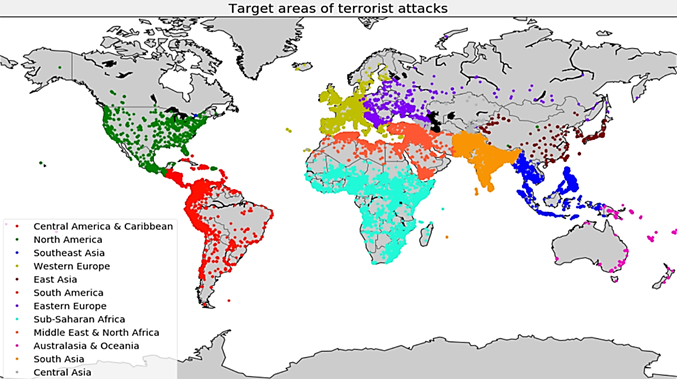INTRODUCTION
1. The Global Terrorism Database (GTD) documents more than 190,000 international and domestic terrorist attacks that occurred worldwide since 1970. With details on various dimensions of each attack, the GTD familiarizes analysts, policymakers, scholars, and journalists with patterns of terrorism.
2. The GTD defines terrorist attacks as: The threatened or actual use of illegal force and violence by a non-state actor to attain a political, economic, religious, or social goal through fear, coercion, or intimidation.
3. For each GTD incident, information is available on the date and location of the incident, the weapons used and nature of the target, the number of casualties, and — when identifiable — the identity of the perpetrator.
4. Compared to most types of criminal violence, terrorism poses special data collection challenges. In response, there has been growing interest in open source terrorist event data bases. One of the major problems with these data bases in the past is that they have been limited to international events — those involving a national or group of nationals from one country attacking targets physically located in another country. Past research shows that domestic incidents greatly outnumber international incidents.
PROPOSED SYSTEM
1. In the proposed system, we are going to use the Global Terrorism Database to analyze and derive insights on the various terrorism acts that have taken place. We will preprocess the database to get reliable and accurate patterns and insights and use descriptive statistics to draw conclusions such as — major causes of terrorism, major groups behind terrorism, categories of the targets, locations of terrorist attacks.
2. Using EDA, we will show the trend of the growth of terrorism in the world and how it spread to various parts of the world. Using graphs, we study how one factor behind terrorism is interrelated to the other.
3. We also do predictive analytics as to what the magnitude of the terrorism acts can be in the future years.
OBJECTIVE OF ANALYSIS AND STUDY
The GLOBAL TERRORISM INDEX defines terrorism as “the threatened or actual use of illegal force and violence by a non-state actor to attain a political, economic, religious, or social goal through fear, coercion, or intimidation”.
The objectives of this project are:
· to study and analyse the different terrorism acts that have taken place in various parts of the world, at different times.
· the various causes behind terrorism acts
· different types of terrorism acts
· categories of terrorism acts
· distribution of terrorism acts
· statistical conclusions
EDA and DESCRIPTIVE ANALYTICS
1. Descriptive analytics is the interpretation of historical data to better understand changes that have occurred in a business. Descriptive analytics describes the use of a range of historic data to draw comparisons. A statistical method that is used to search and summarize historical data in order to identify patterns or meaning. Preliminary stage of data processing that creates a summary.
2. Exploratory data analysis (EDA) is an approach to analyzing data sets to summarize their main characteristics, often with visual methods. EDA is for seeing what the data can tell us beyond the formal modeling or hypothesis testing task. It’s where the researcher takes a bird’s eye view of the data and tries to make some sense of it.
#big-data #exploratory-data-analysis #data-science #data-visualization #descriptive-statistics #data analysis
